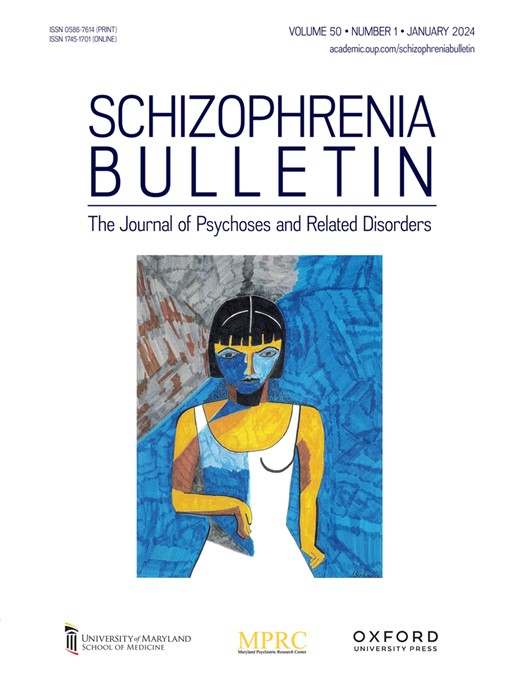Trends in Antipsychotic Polypharmacy and Potential Overtreatment with Antipsychotics: A Naturalistic Cohort Study of People in Long-term Care
IF 5.3
1区 医学
Q1 PSYCHIATRY
引用次数: 0
Abstract
Background Due to the side effects of antipsychotics, overtreatment is an important concern. Previous research focused on antipsychotic polypharmacy and excessively high doses. In this study, the aim is to map changes over the years in potential overtreatment, antipsychotic polypharmacy, total antipsychotic dose, and subjective side effect burden. Moreover, the association of the total dose and antipsychotic polypharmacy with the subjective side effect burden will be investigated. Study design Data from a naturalistic longitudinal cohort were used (PHAMOUS, 2013–2021). Potential overtreatment was defined as a antipsychotic dose equivalent to > 5 mg risperidone or antipsychotic polypharmacy, in combination with a high subjective side effect burden. Mixed effect models were used to investigate trends in potential overtreatment, antipsychotic polypharmacy, total antipsychotic dose, and subjective side effect burden and to assess the association of total dose and antipsychotic polypharmacy with subjective side effect burden. Study results Overall, 15,717 observations nested in 5,107 participants were used. One-third of the participants were potentially overtreated, which did not change over time. The prevalence of a dose above the equivalent of 5 mg risperidone decreased, antipsychotic polypharmacy prevalence increased, and the subjective side effect burden decreased. A higher dose and antipsychotic polypharmacy were associated with higher subjective side effect burden. Conclusion Potentially overtreated patients should be revaluated to assess whether changes are needed. To assess whether a patient is truly overtreated, their clinical history, number of relapses, patients’ preferences, overall functioning, previous attempts to reduce antipsychotic treatment, and previous severity of disease should be taken into account.抗精神病药物的综合用药趋势和潜在的抗精神病药物过度治疗:长期护理人群的自然队列研究
背景:由于抗精神病药物的副作用,过度治疗是一个重要的问题。以往的研究主要集中在抗精神病药物的综合用药和过高剂量。在这项研究中,目的是绘制多年来潜在的过度治疗、抗精神病药物综合用药、抗精神病药物总剂量和主观副作用负担的变化。此外,总剂量和抗精神病药物与主观副作用负担的关系将被调查。研究设计采用自然纵向队列数据(phamus, 2013-2021)。潜在的过度治疗被定义为抗精神病药物的剂量相当于;5毫克利培酮或抗精神病药物,合并高主观副作用负担。采用混合效应模型研究潜在过度治疗、多种抗精神病药物、抗精神病药物总剂量和主观副作用负担的趋势,并评估总剂量和多种抗精神病药物与主观副作用负担的关系。研究结果总体而言,在5107名参与者中使用了15,717项观察结果。三分之一的参与者可能被过度治疗,这种情况不会随着时间的推移而改变。大于等于5mg利培酮剂量的患病率降低,抗精神病药物的多药患病率增加,主观副作用负担减轻。较高的剂量和多药抗精神病药物与较高的主观副作用负担相关。结论应重新评估可能过度治疗的患者,以评估是否需要改变。为了评估患者是否真的被过度治疗,他们的临床病史、复发次数、患者的偏好、整体功能、以前减少抗精神病药物治疗的尝试以及以前的疾病严重程度都应该考虑在内。
本文章由计算机程序翻译,如有差异,请以英文原文为准。
求助全文
约1分钟内获得全文
求助全文
来源期刊

Schizophrenia Bulletin
医学-精神病学
CiteScore
11.40
自引率
6.10%
发文量
163
审稿时长
4-8 weeks
期刊介绍:
Schizophrenia Bulletin seeks to review recent developments and empirically based hypotheses regarding the etiology and treatment of schizophrenia. We view the field as broad and deep, and will publish new knowledge ranging from the molecular basis to social and cultural factors. We will give new emphasis to translational reports which simultaneously highlight basic neurobiological mechanisms and clinical manifestations. Some of the Bulletin content is invited as special features or manuscripts organized as a theme by special guest editors. Most pages of the Bulletin are devoted to unsolicited manuscripts of high quality that report original data or where we can provide a special venue for a major study or workshop report. Supplement issues are sometimes provided for manuscripts reporting from a recent conference.
 求助内容:
求助内容: 应助结果提醒方式:
应助结果提醒方式:


